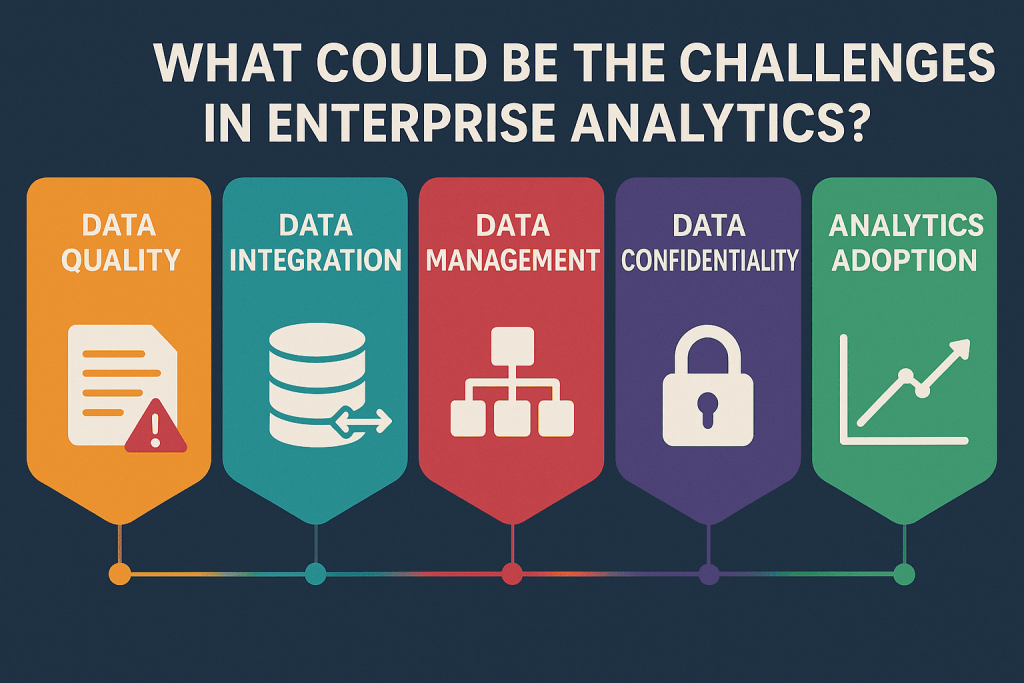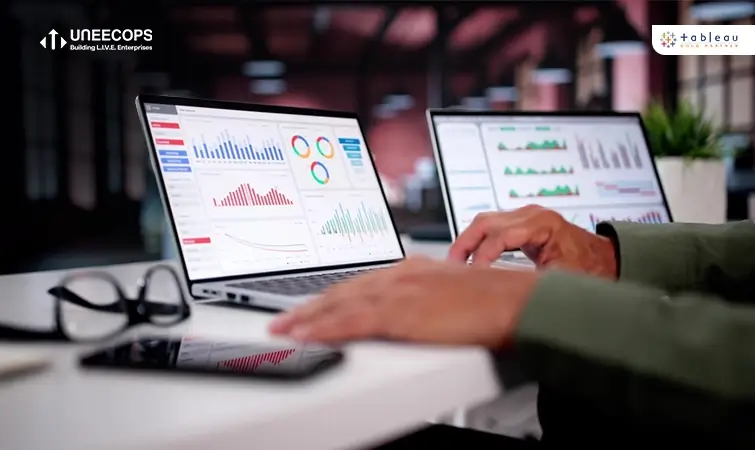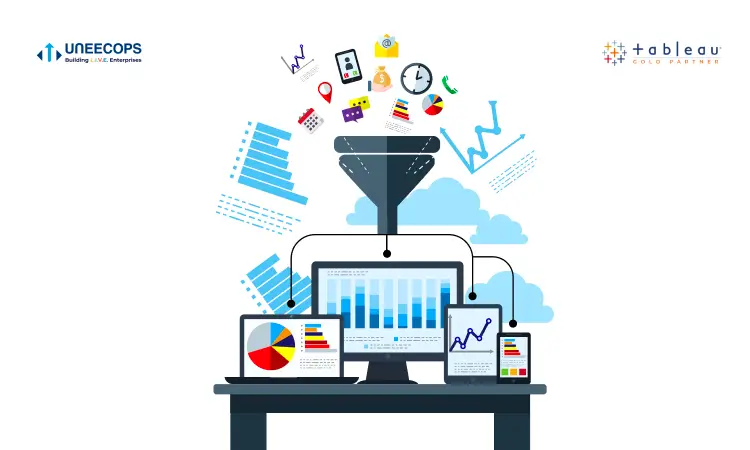Every organization strives to reach peak performance, and today’s competitive landscape calls for strong enterprise analytics as the foundation. But just as physical fitness has different levels, so does your Enterprise Analytics Fitness Level. Are you data-strong and nimble, or is your enterprise analytics routine overdue for a serious workout? Let’s explore how Tableau can help you boost your enterprise analytics “fitness” and climb to new heights of data-driven excellence.
Assessing Your Analytics Fitness Level – What Is Your Enterprise Analytics Maturity?
Every fitness journey begins with an honest assessment. How do you determine where your organization stands?
- Beginner: Ask yourself, “Does my data give me insights on KPIs, year-on-year revenue or business performance?” Basic reports and static dashboards give you the big picture but lack granularity. Insights might be slow, and it’s challenging to keep up with real-time changes.
- Intermediate: Ask yourself, “I have data, dashboards and decision-making capabilities but is everything still not happening at the speed of business?” Probably, you’ve got some interactive dashboards, and you’re experimenting with data from different sources. Teams can start answering questions, but the process is often slow.
- Advanced: Ask yourself, “Am I able to do trend analysis and draw predictive insights from my dashboards using built-in AI tools?” Analytics is integrated across departments. Real-time insights are within reach, and teams can dive deeper into data for a competitive edge.
- Elite: Ask yourself, “Am I able to assess my organization’s past performance and use analytics to predict future course of action?” Then, machine learning integration and AI-driven analytics are fully embedded in your decision-making processes. Predictive insights are guiding strategy, and you’re spotting trends before they arise, setting the pace in your industry.
Where does your organization fall on this spectrum? Whether you’re just getting started or aiming for elite performance, Tableau can elevate your analytics capabilities and take you to the top.
Calculator 2.0 – Identifying Types of Enterprise Analytics
If the above is complex, you can identify the types of enterprise analytics and map your analytics fitness level to it. These types of enterprise analytics indicators are the best fit in the AI era to ascertain where you are and where you need to be. View the infographic below to learn more:
- Descriptive Analytics (Learn what happened)
If you mine data and apply reporting and visualizations to summarize business performance and current KPIs, you are at the descriptive analytics stage.
2. Diagnostic Analytics (Learn why it happened)
If you apply root cause and drill-down techniques to uncover patterns and relationships behind outcomes, you are at the diagnostic analytics phase.
3. Predictive Analytics (Predict what could happen in the future)
If you capitalize on machine learning and statistical models to forecast trends and foresee what’s next for your business based on current data, you are using predictive analytics.
4. Prescriptive Analytics (Suggest what should be done in the future)
If your analytics tools simulate scenarios and recommend actions by analyzing past performance and potential outcomes, you are at this stage.
Rewind and check what type of enterprise analytics stage you are in. This can help you understand challenges in enterprise analytics and how to overcome them. Make note that these are similar and mapped to the ‘beginner’ to ‘elite’ analytics fitness levels mentioned above.
What Could Be the Challenges in Enterprise Analytics?
You must know the challenges in enterprise analytics that your C-suite, sales leaders and product executives could possibly face. Only then can you move forward to the next level of enterprise analytics fitness. The challenges in enterprise analytics can be:

- Data quality: Your data is not collated or updated adequately.
- Data integration: Your department or region data is not included, or some systems are not synced.
- Data management: You are unable to complete the cycle of data analysis due to mismanagement.
- Data confidentiality: Your data is at risk due to tools or lack of proper adoption.
- Analytics adoption: Your team does not have the data skills or dashboard creation abilities, and hence the tools at your organization’s disposal are not being used effectively.
When you know these gap areas, you can easily assess which stage of enterprise fitness you are in, what types of enterprise analytics level you need, and how can Tableau or your support partner help you overcome the challenges in enterprise analytics. You can request a consultation from our experts or read on to find out more about Tableau’s AI enterprise analytics capabilities.
Building Data Strength: Adding Core Insights with Tableau Business Analytics
Tableau business analytics helps you fortify your core insights by making complex data accessible and actionable. With its user-friendly dashboards, Tableau transforms your raw data into clear, visual insights, allowing teams to make quick, confident decisions. Here’s how Tableau leverages AI for data visualization, forecasting, and decision-making support.
- Enhanced visualization: Simplifies complex data for easy analysis and decision-making.
- Self-service analytics: Empowers every team member to generate their own insights, reducing bottlenecks.
- Intuitive interface: Makes data approachable for users of any skill level, even those new to analytics.
- Real-time dashboards: Provide live updates to track metrics as they happen, ensuring you’re never behind.
- Ad hoc analysis: Allows teams to explore questions on the fly, without waiting for static reports.
The New Steroid for Enterprise Analytics – Tableau BI Solutions + AI (Leveraging AI with Tableau BI)
For crushing enterprise analytics, just like athletes turning to cutting-edge training techniques to stay competitive, businesses need more than basic metrics to win the data game. Enter the new power duo in enterprise analytics: Tableau BI solutions + AI—the equivalent of a performance-enhancing boost for your data strategy. How can this improve your enterprise analytics fitness levels? Below we reflect on this:
Tracking everything: A training regimen is where every rep is optimized, and every movement is tracked accurately. That’s like the level of precision Tableau BI solutions + AI brings to enterprise analytics. With AI-driven analytics in the mix, Tableau doesn’t just visualize your data; it anticipates trends, spots patterns, and drills down to the insights that matter most. It’s like having a world-class coach and a sports scientist all in one, ensuring every data point adds to your team’s winning strategy.
Fast decisions: Today’s business world is fast-paced, and agility is everything. So, as athletes train for explosive speed and quick decision-making, Tableau BI solutions + AI-driven analytics empower your team to sprint toward insights at record-breaking speeds. With real-time data processing and predictive capabilities, decisions that used to take days can now happen in seconds. Tableau + AI helps you adapt, pivot, and make the calls that drive your team over the finish line.
Data strategies for long-term success: Building data strategies with staying power is like training for a marathon. You need endurance, resilience, and consistency. Tableau BI solutions + AI doesn’t just help you hit short-term targets—it’s built to keep you strong in the long run. With robust analytics tools and forecasting power, your organization can pace itself, setting goals for steady, sustainable growth while keeping an eye on the competition.
While Tableau + AI is like steroids, AI is the real game-changer in this mix.
The ‘AI’ Boost for Energetic Enterprise Analytics
While using Tableau BI solutions, AI is like that energy booster that supercharges the whole enterprise analytics process, from data collection to predictive forecasting. Let us see how:
- Data collection: Collating data is no easy feat. AI can help with data cleansing and make the collection process easier.
- Data preparation: Generative AI can be particularly useful for data standardization, which refers to adjusting values measured on diverse scales to a standard scale.
- Predictive analytics: Generative AI can predict the future by analyzing vast data sets to identify patterns and trends. For instance, a city’s public transportation department could use generative AI to predict future transit demands. The AI would analyze historical ridership data, population growth trends, urban development plans, and even weather patterns to project changes in transit usage. This predictive insight would enable city planners to adjust routes, schedules, and resource allocation efficiently, improving service while managing costs.
Your Enterprise Analytics Requires Commitment and Consistency
Tableau is the all-in-one solution to elevate your organization’s data strength, agility, and endurance. Whether you’re setting out on your analytics journey or pushing toward elite status, Tableau has everything you need to reach the summit.
Boost your Enterprise Analytics Fitness Level with Tableau and unlock the true potential of your data. The trail is set, and with a trusted Tableau Gold partner like Uneecops by your side, you’re equipped to make it to the top. So, lace up, and let’s get data hiking!







